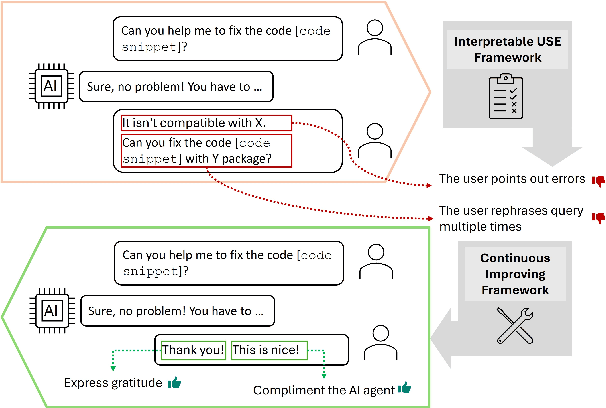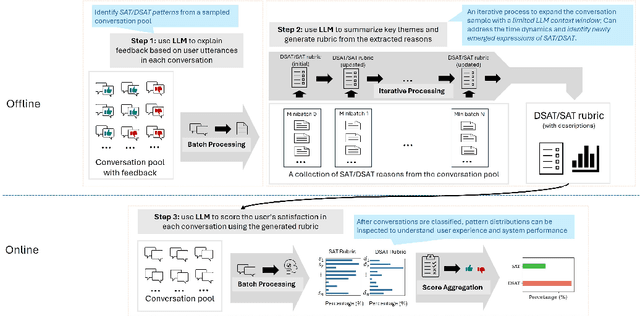Scott Counts
Speaking the Right Language: The Impact of Expertise Alignment in User-AI Interactions
Feb 25, 2025



Abstract:Using a sample of 25,000 Bing Copilot conversations, we study how the agent responds to users of varying levels of domain expertise and the resulting impact on user experience along multiple dimensions. Our findings show that across a variety of topical domains, the agent largely responds at proficient or expert levels of expertise (77% of conversations) which correlates with positive user experience regardless of the user's level of expertise. Misalignment, such that the agent responds at a level of expertise below that of the user, has a negative impact on overall user experience, with the impact more profound for more complex tasks. We also show that users engage more, as measured by the number of words in the conversation, when the agent responds at a level of expertise commensurate with that of the user. Our findings underscore the importance of alignment between user and AI when designing human-centered AI systems, to ensure satisfactory and productive interactions.
The Emerging AI Divide in the United States
Apr 18, 2024



Abstract:The digital divide describes disparities in access to and usage of digital tooling between social and economic groups. Emerging generative artificial intelligence tools, which strongly affect productivity, could magnify the impact of these divides. However, the affordability, multi-modality, and multilingual capabilities of these tools could also make them more accessible to diverse users in comparison with previous forms of digital tooling. In this study, we characterize spatial differences in U.S. residents' knowledge of a new generative AI tool, ChatGPT, through an analysis of state- and county-level search query data. In the first six months after the tool's release, we observe the highest rates of users searching for ChatGPT in West Coast states and persistently low rates of search in Appalachian and Gulf states. Counties with the highest rates of search are relatively more urbanized and have proportionally more educated, more economically advantaged, and more Asian residents in comparison with other counties or with the U.S. average. In multilevel models adjusting for socioeconomic and demographic factors as well as industry makeup, education is the strongest positive predictor of rates of search for generative AI tooling. Although generative AI technologies may be novel, early differences in uptake appear to be following familiar paths of digital marginalization.
Interpretable User Satisfaction Estimation for Conversational Systems with Large Language Models
Mar 19, 2024



Abstract:Accurate and interpretable user satisfaction estimation (USE) is critical for understanding, evaluating, and continuously improving conversational systems. Users express their satisfaction or dissatisfaction with diverse conversational patterns in both general-purpose (ChatGPT and Bing Copilot) and task-oriented (customer service chatbot) conversational systems. Existing approaches based on featurized ML models or text embeddings fall short in extracting generalizable patterns and are hard to interpret. In this work, we show that LLMs can extract interpretable signals of user satisfaction from their natural language utterances more effectively than embedding-based approaches. Moreover, an LLM can be tailored for USE via an iterative prompting framework using supervision from labeled examples. The resulting method, Supervised Prompting for User satisfaction Rubrics (SPUR), not only has higher accuracy but is more interpretable as it scores user satisfaction via learned rubrics with a detailed breakdown.
TnT-LLM: Text Mining at Scale with Large Language Models
Mar 18, 2024Abstract:Transforming unstructured text into structured and meaningful forms, organized by useful category labels, is a fundamental step in text mining for downstream analysis and application. However, most existing methods for producing label taxonomies and building text-based label classifiers still rely heavily on domain expertise and manual curation, making the process expensive and time-consuming. This is particularly challenging when the label space is under-specified and large-scale data annotations are unavailable. In this paper, we address these challenges with Large Language Models (LLMs), whose prompt-based interface facilitates the induction and use of large-scale pseudo labels. We propose TnT-LLM, a two-phase framework that employs LLMs to automate the process of end-to-end label generation and assignment with minimal human effort for any given use-case. In the first phase, we introduce a zero-shot, multi-stage reasoning approach which enables LLMs to produce and refine a label taxonomy iteratively. In the second phase, LLMs are used as data labelers that yield training samples so that lightweight supervised classifiers can be reliably built, deployed, and served at scale. We apply TnT-LLM to the analysis of user intent and conversational domain for Bing Copilot (formerly Bing Chat), an open-domain chat-based search engine. Extensive experiments using both human and automatic evaluation metrics demonstrate that TnT-LLM generates more accurate and relevant label taxonomies when compared against state-of-the-art baselines, and achieves a favorable balance between accuracy and efficiency for classification at scale. We also share our practical experiences and insights on the challenges and opportunities of using LLMs for large-scale text mining in real-world applications.
Using Large Language Models to Generate, Validate, and Apply User Intent Taxonomies
Sep 14, 2023



Abstract:Log data can reveal valuable information about how users interact with web search services, what they want, and how satisfied they are. However, analyzing user intents in log data is not easy, especially for new forms of web search such as AI-driven chat. To understand user intents from log data, we need a way to label them with meaningful categories that capture their diversity and dynamics. Existing methods rely on manual or ML-based labeling, which are either expensive or inflexible for large and changing datasets. We propose a novel solution using large language models (LLMs), which can generate rich and relevant concepts, descriptions, and examples for user intents. However, using LLMs to generate a user intent taxonomy and apply it to do log analysis can be problematic for two main reasons: such a taxonomy is not externally validated, and there may be an undesirable feedback loop. To overcome these issues, we propose a new methodology with human experts and assessors to verify the quality of the LLM-generated taxonomy. We also present an end-to-end pipeline that uses an LLM with human-in-the-loop to produce, refine, and use labels for user intent analysis in log data. Our method offers a scalable and adaptable way to analyze user intents in web-scale log data with minimal human effort. We demonstrate its effectiveness by uncovering new insights into user intents from search and chat logs from Bing.
 Add to Chrome
Add to Chrome Add to Firefox
Add to Firefox Add to Edge
Add to Edge